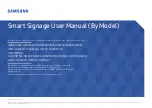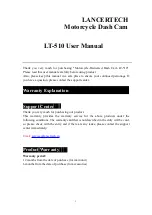
Chapter
10
Operating Instructions
ICR890 High-end CCD Camera System
118
©
SICK AG · Division Auto Ident · Germany · All rights reserved
8011325/0000/2006-10-24
Appendix
10.6
Glossary
Also see the SOPAS-ET Configuration Software online help for further terms.
1-D code (bar code, strip code)
Field of dark strips (bars) and light spaces (elements) arranged in parallel, which, by working
to a certain rule (specification), can be represented on the medium (subsurface) by various
print processes. A user-readable (alpha)numeric character is produced from each machine-
readable, corresponding number and combination of strips and spaces. Since the entire
coded information, framed by start and stop characters, is available as a whole in one
dimension and is also mostly analyzed by line, these bar codes are referred to as linear
codes. The various code types differ in their codeable character inventory, design (number
of elements per character, number of characters, start/stop characters, check characters),
their information density and in their print tolerances. The length of the code strips and
spaces has no bearing on the information content. However, longer code strips and spaces
can be more easily analyzed by the reading device.
2-D codes
In two dimensional codes the information is arranged more densely in a matrix with the help
of dark and light cells (quadrates). The vertical and horizontal arrangement of the cells in
relation to the reference points in the centre and on the edges, determines the data content
which is defined by the specification. In the case of error correction during reading, the code
is tagged with a redundancy by way of a mathematical process (e. g. for Data Matrix ECC200
via error correction code words). The unidirectional reading of 2-D codes is carried out by
way of image processing.
Aperture angle
α
Aperture within the boundaries of which the ICR890 System is able to analyze codes
(through the lenses). A V-shaped area appears radially in front of the reading window,
across the direction of transport (reading from above), in which the codes to be read must
be positioned.
Aspect ratio
For bar codes with the code height (strip length) to code length (number of characters) ratio.
Bar codes with very low ratios can be read using the SMART decoder.
Aux interface
Auxiliary data interface (RS 232) of the ICR890 System with fixed data output format.
Access to the ICR890 System for operation and configuration is always possible via this
interface, using the SOPAS-ET Configuration Software. Among other things, the interface
controls the output of
Ö
system and error messages and can be allocated various
functions. Aux interface communication can also be executed via the Ethernet interface
(port 2111).
CAN interface
Controls construction of a rapid SICK-specific CAN SENSOR network with various functions
(e. g. multiplexer, master/slave) or integration into existing CAN networks after the CAN
open protocol. Access to the ICR890 System for operation and configuration is possible via
the CAN interface (network) using the SOPAS-ET Configuration Software in remote mode.











































